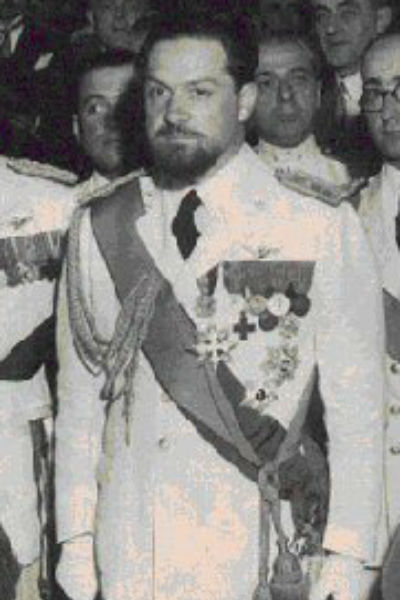Balbo, Italo
- Date of birth:
- June 6th, 1896 (Quartesana/Ferrara, Italy)
- Date of death:
- June 28th, 1940 (Over Tobruk, Libia)
- Buried on:
- Italian War Graves & Wall of Remembrance Orbetello
- Nationality:
- Italian
Biography
Italo Balbo served with the Italian Alpine Corps from 1914 until 1915. During the years 1915 until 1926 he was decorated three times for his flying skills. In 1920 he was appointed to Secretary for the Italian Fascist Party in Ferrara.
He led the 4000 troops in the Battle of Ravenna on March 24th and 25th 1921. He took part in the Fascist "March on Rome" in 1922. After this he led the military operations in Northern Italy. In April 1922 he forced the Italian Government toe release Fascist held in Bologna. On May 12th Balbo organised a general strike of 63000 fascists in Ferrara, forcing the local government to resign. On the 29th of that same month he led 20000 member of the armed Fascist Militia in occupying Bologna. Bloodshed was prevented after intervention of Mussolini. After several military actions he ceased hostilities on July 30th 1922 and ordered his troops back to Ravenna. When he received a call for help he started actions again in August. A major clash erupted between Balbo’s troops and the Socialist Arditi. After interventions of Mussolini, he was ordered back again. From then he was more under command of Mussolini himself.
In 1923 Balbo was promoted to General of the Militia, but he resigned after loosing a law sued against the "Voce Republicana" who accused him of murdering a priest in Ferrara. For some time he worked as a reporter for the "Il Corriere". In 1926 he was appointed Under-Secretary of State for Aviation and in 1929 followed his appointment as Under-Secretary responsible for Economy. In 1930 Balbo was appointed Minister of Defence.
When on June 30th 1933, specially trained pilots, demonstrated a mass formation flight with 25 Savoia-Marchetti SM.55X flying boats, this resulted in stating such large groups in a formation as "Balbos". Balbo flew with this total formation from Rome to Chicago to demonstrate the possibilities and the skills of the Italian Airmen.
In honour of his journey to the Century of Progress Exposition, Chicago renamed 7th Street as Balbo Drive. Afterwards he and his crews were treated to a ticker-tape parade in New York and lunch with President Roosevelt.
During the Spanish Civil War he directed air attacks against Republican shipping in the Mediterranean. In December 1939 he was appointed Governor of Libya by Mussolini, who wanted to get him out of the way. He transformed the colony from the dark ages to a model Italian province. In May 1940 he remarked publicly on Italy's inability to strike in Libya because of its lack of arms and equipment.
On June 2nd 1940 he met Ciano to discuss Italy's position regarding the continuation of the conflict in Libya.
On June 28th he was ordered to invade Egypt, but was killed when his plane was shot down by
Italian anti-aircraft fire over Tobruk. Some authors suggest that Ciano was behind the act, but documentary proof is never found.
28.03.1942: Mussolini presents Balbo's son with the Gold medal for fallen aviators.
Do you have more information about this person? Inform us!
- Period:
- First World War (1914-1918)
- Rank:
- Tenente (Lieutenant)
- Unit:
- Battaglione Alpini "Pieve di Cadore", Regio Esercito
- Dosso Casina July-August 1918
- Period:
- First World War (1914-1918)
- Rank:
- Tenente (Lieutenant)
- Unit:
- Battaglione Alpini "Pieve di Cadore", Regio Esercito
- Monte Valderoa 27 October 1918
- Period:
- First World War (1914-1918)
- Rank:
- Tenente (Lieutenant)
- Unit:
- Battaglione Alpini "Pieve di Cadore", Regio Esercito
- Monte Valderoa-Rasai (Val di Seren) 27-31 October 1918
- Awarded on:
- 1931
- Orbetello-Rio de Janeiro, December 17, 1930 - January 15, 1931.
- Rank:
- Maresciallo dell’Aria (Air Marshal)
- Awarded on:
- April 10th, 1935
--
From July 1 - August 12, 1933 he led a flight of 24 flying boats on a round-trip flight from Rome to the Century of Progress in Chicago, Illinois.
- Period:
- Second World War (1939-1945)
- Rank:
- Maresciallo dell’Aria (Air Marshal)
- Awarded on:
- 1940
While preparing to hurl the valiant troops and the mighty flocks across the border, he concluded his heroic life with the supreme sacrifice in the Tobruk airspace.
His deeds are eternalized in the memory of the people and with glories of the race."
- Tobruk airspace, June 28, 1940
- Period:
- First World War (1914-1918)
- Period:
- Second World War (1939-1945)
- Period:
- Second World War (1939-1945)
- Period:
- First World War (1914-1918)
- Period:
- First World War (1914-1918)
- Period:
- First World War (1914-1918)
Sources
- Photo: STIWOT
- - 'Glittering Prizes', by David Lyne-Gordon
- Lexikon der Wehrmacht
- Wehrmacht Awards
- Le onorificenze della Repubblica Italiana
- 74TH CONGRESS. SESS. I. CHS. 56, 57. APRIL 10, 11, 1935.





















